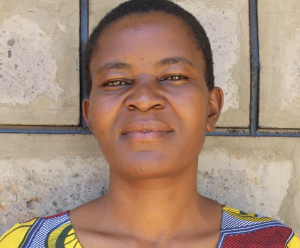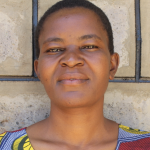Asakari Spring serves 175 people in Imbiakalo Community. This rural area is peaceful and far away from the main road, surrounded by vegetation and traditional houses. Most families here are Muslims, and farming is the primary livelihood. People plant crops, including potatoes, bananas, fruits, and vegetables, some of which they take to the nearest market to sell. Community members here will also hire their neighbors for casual jobs on each other's farms or businesses to help them earn an extra coin.
In its unprotected state, Askari Spring looks more like a shallow stream than a spring. The area is both rocky and muddy, with bushes on either side of the water.
"Our environment at the water point is not encouraging because you can easily slide and break your leg," said teenager Lilian Mayavi.
To fetch water, community members must either submerge their containers in the small pool of water or use smaller jugs and bowls to scoop water from the pool to pour into their larger jerrycans. Both ways bring the dirt and bacteria from people's containers directly into the water they are fetching. However, the process is time-consuming and contaminates the water even further.
The most common toxins in the water come from surface runoff after the rains, which carry farm chemicals, dirt, and animal waste straight to the spring. Animals frequently walk through the spring, drink directly from it, and leave their waste in the area. People will also wash off their feet and legs directly downstream of where others are fetching water, compromising the area's hygiene surrounding the waterpoint.
"We need to learn more about hygiene and sanitation from you because in this community, we are not maintaining hygiene, and it is risky for our lives," reported Wilbroda Injete, a 29-year-old farmer and mother in the community.
The combination of unsafe water and poor hygiene practices leads to a high rate of water-related illnesses among families who depend on Askari Spring for water. Time spent at home sick means less time at work, on the farm, and at school for community members. Waterborne diseases cost families the resources they would have spent on their businesses or children's school fees as they must redirect their money to pay for medical treatments when they are sick. The dirty water at the spring holds everyone back from reaching their full potential, regardless of age or occupation.
What We Can Do:
Spring Protection
Protecting the spring will help provide access to cleaner and safer water and reduce the time people have to spend to fetch it. Construction will keep surface runoff and other contaminants out of the water. With the community’s high involvement in the process, there should be a good sense of responsibility and ownership for the new clean water source.
Fetching water is a task predominantly carried out by women and young girls. Therefore, protecting the spring and offering training and support will help empower the female members of the community by freeing up more of their time and energy to engage and invest in income-generating activities and their education.
Training on Health, Hygiene, COVID-19, and More
To hold training during the pandemic, we work closely with both community leaders and the local government to approve small groups to attend training. We ask community leaders to invite a select yet representative group of people to attend training, which will then act as ambassadors to the rest of the community to share what they learn. We also communicate our expectations of physical distancing and wearing masks for all who choose to attend.
The training will focus on improved hygiene, health, and sanitation habits in this community. We will also have a dedicated session on COVID-19 symptoms, transmission routes, and prevention best practices.
With the community’s input, we will identify key leverage points to alter their practices at the personal, household, and community levels to affect change. This training will help to ensure participants have the knowledge they need about healthy practices and their importance to make the most of their water point as soon as the water is flowing.
Our team of facilitators will use a variety of methods to train community members. Some of these methods include participatory hygiene and sanitation transformation, asset-based community development, group discussions, handouts, and demonstrations at the spring.
One of the most important issues we plan to cover is handling, storing, and treating water. Having a clean water source will be extremely helpful, but it is useless if water gets contaminated by the time it is consumed. The community and we strongly believe that all of these components will work together to improve living standards here, which will help to unlock the potential for these community members to live better, healthier lives.
We will then conduct a small series of follow-up training before transitioning to our regularly scheduled support visits throughout the year.
Training will result in the formation of a water user committee, elected by their peers, that will oversee the spring's operations and maintenance. The committee will enforce proper behavior around the spring and delegate tasks that will help preserve the site, such as building a fence and digging proper drainage channels. The fence will keep out destructive animals and unwanted waste, and the drainage will keep the area’s mosquito population at a minimum.

 Protected Spring
Protected Spring
 Rehabilitation Project
Rehabilitation Project












































